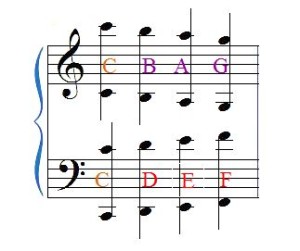| This reading music lesson is a supplement to the Alfred’s Essentials of Music Theory self-study workbook. While no book is perfect for learning how to read music, this is one of the best available. The concise explanations, brief practice exercises, ear-training CD’s, glossary of music terms, and answer key make it an excellent value. Buy this top-rated self-study course for beginners to advanced musicians and follow along with me. |
We’ve already learned about the grand staff and the ledger lines of the treble clef and bass clef.
But, what does it look like when we put it all together?
It looks like this…

Relationships Within the Grand Staff Ledger Lines
There are 3 things you need to take special note of:
1) The only note shared between the two staves is middle C.
You will not find any other note in common between the treble clef and bass clef.
2) Two Ledger lines above the treble clef staff and two ledger lines below the bass clef staff is also the note C.
Recognizing this right away will give you yet another place to start from working your way up or down the music alphabet and ledger lines in order to figure out the rest of the notes.
3) The ledger line notes above and below the treble clef use the same letter name. This is also true for the bass clef.
Well, now that you’ve learned some key relationships within the grand staff ledger lines, it’s time to move on to learning some rhythm. Let’s start with a discussion on finding the beat.
